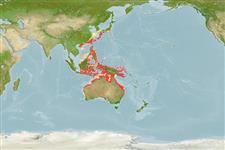>
Perciformes/Serranoidei (Groupers) >
Epinephelidae (Groupers)
Etymology: Epinephelus: Greek, epinephelos = cloudy (Ref. 45335).
Eponymy: Jean René Constant Quoy (1790–1869) was a French naval surgeon and zoologist who named many species, often with Joseph Paul Gaimard (q. [...] (Ref. 128868), visit book page.
More on author: Valenciennes.
Environment: milieu / climate zone / depth range / distribution range
ນິເວດວິທະຍາ
ສັດທະເລ ກ່ຽວກັນຫີນ; ລະດັບຄວາມເລິກ ? - 50 m (Ref. 5222). Tropical; 35°N - 32°S, 110°E - 156°E (Ref. 5222)
Western Pacific: Japan to Australia. Unknown from the Indian Ocean except for the Andaman Islands record (as Serranus merra). Unreported from islands of Micronesia, Melanesia and central Pacific. Often misidentified as Epinephelus macrospilos or Epinephelus hexagonatus.
Length at first maturity / ຂະໜາດ / ນ້ຳໜັກ / Age
Maturity: Lm ?, range 18 - ? cm
Max length : 40.0 cm TL ຕົວຜູ້/ບໍ່ມີເພດ; (Ref. 48635)
ຄີ (ໜາມ)ແຂງຢູ່ຫຼັງປາ (ທັງໝົດ) : 11; ຄີຫຼັງຂອງປາ (ຄີອ່ອນ) (ທັງໝົດ) : 16 - 18; ຄີ(ໜາມ) ແຂງຢູ່ຄີກົ້ນປາ
ກຸ່ມປາກະດູກແຂງ
ຄວາມຖີ່ຂອງກຸ່ມຖ່າຍທອດພັນ
ປາທີ່ມີການເຄື່ອນຍ້າຍຈາກທະເລໄປຫານ້ຳຈືດ ແລະນ້ຳຈືດຫາທະເລ
ປາທີ່ມີການເຄື່ອນຍ້າຍຈາກທະເລແລະໄປໄຂ່ຢູ່ນ້ຳຈືດ
ຄີກົ້ນຂອງປາ
ສັດທີ່ມີກະດູກສັນຫັຼງ
ການຖ່າຍທອດທາງກຳມະພັນຈາກພໍ່ແມ່ຫາລູກ: 3; ຄີກົ້ນຂອງປາ: 8. Distinguished by the following characteristics: whitish color; head, body and fins with numerous large close-set hexagonal to roundish dark brown to blackish spots; ctenoid body scales except cycloid dorsoanteriorly above lateral line, on thorax and abdomen; body with auxiliary scales; greatest depth of body 2.7-3.2 in SL; rounded caudal fin; pelvic fins, 1.7-2.1 in head length (Ref. 90102); head length 2.3-2.6 times in SL; evenly curved dorsal head profile; snout subequal to eye diameter, snout length 4.6-5.3 times in HL; rounded preopercle or subangular; upper edge of operculum almost straight; posterior nostril diameter about twice that of anterior nostrils; maxilla reaches to or past vertical at rear edge of eye; 2-3 rows of teeth on midlateral part of lower jaw; lower jaw barely projecting in front of upper jaw (Ref. 89707).
Inhabits inshore silty reefs; there are no records from depths greater than 50 m. Feeds on shrimps, small fishes, worms and crabs (Ref. 89707). The enlarged fleshy pectoral fins appear to have resulted from its habit of sitting on the substrate. Solitary (Ref 90102).
Life cycle and mating behavior
ການຈະເລີນເຕັມໄວ | ການສືບພັນ | ການວາງໄຂ່ | ໄຂ່ | ຄວາມດົກຂອງໄຂ່ປາ | ຕົວອ່ອນ
Heemstra, P.C. and J.E. Randall, 1993. FAO Species Catalogue. Vol. 16. Groupers of the world (family Serranidae, subfamily Epinephelinae). An annotated and illustrated catalogue of the grouper, rockcod, hind, coral grouper and lyretail species known to date. Rome: FAO. FAO Fish. Synop. 125(16):382 p. (Ref. 5222)
IUCN Red List Status (Ref. 130435: Version 2024-2)
Threat to humans
Reports of ciguatera poisoning (Ref. 30298)
Human uses
ການປະມົງ: ເປັນສີນຄ້າ
ເຄື່ອງມື
Special reports
Download XML
ແຫຼ່ງອີນເຕີເນັດ
Estimates based on models
Preferred temperature (Ref.
123201): 24.5 - 28.9, mean 27.7 °C (based on 504 cells).
Phylogenetic diversity index (Ref.
82804): PD
50 = 0.5000 [Uniqueness, from 0.5 = low to 2.0 = high].
Bayesian length-weight: a=0.01349 (0.00855 - 0.02128), b=3.05 (2.92 - 3.18), in cm total length, based on LWR estimates for this species & Genus-body shape (Ref.
93245).
ຊັ້ນເຂດຮ້ອນ (Ref.
69278): 4.0 ±0.5 se; based on diet studies.
ຄວາມຢືດຢຸ່ນ (Ref.
120179): ຂະໜາດກາງ, ປະຊາກອນຕຳ່ສຸດທີ່ໃຊ້ເວລາສອງເທົ່າ 1.4 - 4.4 ປີ (Preliminary K or Fecundity.).
Fishing Vulnerability (Ref.
59153): Low to moderate vulnerability (30 of 100).
Nutrients (Ref.
124155): Calcium = 34 [16, 71] mg/100g; Iron = 0.584 [0.306, 1.188] mg/100g; Protein = 18.4 [16.8, 19.8] %; Omega3 = 0.125 [0.078, 0.197] g/100g; Selenium = 30.1 [16.9, 58.5] μg/100g; VitaminA = 329 [88, 1,239] μg/100g; Zinc = 1.27 [0.85, 1.83] mg/100g (wet weight);
